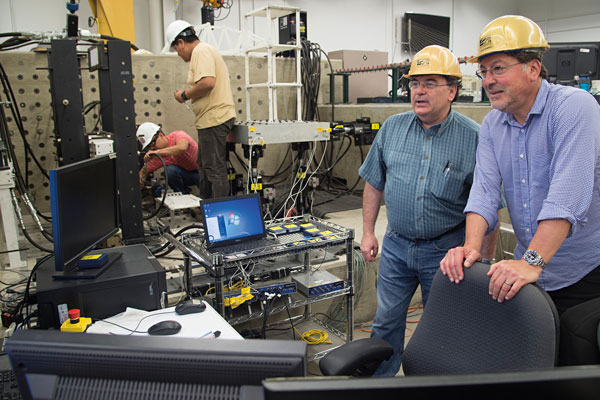Purdue to lead multihazard research with $4.1 million NSF award
Purdue to lead multihazard research with $4.1 million NSF award
| Author: | Marti LaChance, Phillip Fiorini |
|---|---|
| Magazine Section: | Breaking News |
| Article Type: | Feature |
Purdue University has received a five-year, $4.1 million grant by the National Science Foundation to help coordinate a national initiative aimed at minimizing damage to physical civil infrastructure.
A Purdue team led by Civil Engineering professor Julio Ramirez will direct the Network Coordination Office for the National Hazards Engineering Research Infrastructure effort by engineers and scientists to investigate methods for making civil infrastructure safer and making communities more resilient.
"Purdue was viewed as the most suitable institution to lead the community, coordinate the large investment of the NSF and to conduct education and community outreach activities of this research infrastructure," Ramirez said.
From 2009 to 2014, Ramirez served as director for NSF's George E. Brown Jr. Network for Earthquake Engineering Simulation, a $105 million grant aimed at mitigating earthquake damage. The NHERI grant is multihazard, combining investigations from the earthquake, wind and coastal engineering and social sciences communities.
Along with the NCO, the NHERI network consists of eight experimental facilities, a cyberinfrastructure platform for collaboration and a simulation center — components located at universities around the country.

"The NHERI NCO will lead the engineering community into adopting sustainable multihazard approaches," Ramirez said. "With NEES, our focus was earthquakes and associated natural hazards such as tsunamis and landslides. With NHERI, we focus on windstorms and associated hazards such as coastal storm surge and inundation, too. Things that we've learned in earthquake engineering can be applied to engineering for windstorms and vice versa.
"Most importantly, we want engineers and scientists to become multihazard in their thinking, to approach resilience of communities as a whole."
Other Purdue researchers on the NCO team are Antonio Bobet, professor of civil engineering, who brings extensive geotechnical engineering expertise; and David R. Johnson, assistant professor with joint appointments in political science and industrial engineering. Johnson has experience in interdisciplinary methods and scientific research to inform policymaking and social science research.
Co-principal investigators on the NCO team are JoAnn Browning, dean of the College of Engineering at the University of Texas at San Antonio; Billy Edge, professor of civil, construction and environmental engineering at North Carolina State University and head of coastal processes and engineering at the Coastal Studies Institute at the University of North Carolina; and Delong Zuo, associate professor of civil, environmental and construction engineering at Texas Tech University.

The first step for the Purdue-based NCO is to lead the community and the other NHERI awardees into developing NHERI's formal research agenda, a five-year science plan, Ramirez said.
"It's an articulation of the priorities, grand challenges and the key problems we're going to solve," he said. "This science plan, developed by the research community, will in turn become the research agenda that NSF and other agencies will fund to make our infrastructure safer against windstorms and earthquakes. One of the key goals is to bring together those two very different research communities, people formerly working on the separate paths of earthquake and wind engineering."
The NCO team also will work with NHERI's experimental facilities to ensure the efficient testing of new technologies within a safe environment, to centrally coordinate testing schedules, and to facilitate shared technical knowledge and best practices. Other key NCO efforts are to lead NHERI education and outreach and develop strategic partnerships around the world to form a cohesive, global natural-hazards engineering research infrastructure.
Additional key senior personnel are practicing earthquake engineer William Holmes, who has extensive experience in developing codes and guidelines; architect Thomas Smith, who has expertise in windstorm damage; Cheryl Ann Blain, a research oceanographer of the Naval Research Laboratory, Oceanography Division, who is an expert in the application of numerical models based on unstructured grids to coastal dynamics, numerical tide and storm surge modeling; and professor Ian Robertson of the University of Hawaii, Manoa, who is an expert in tsunami and coastal engineering research.